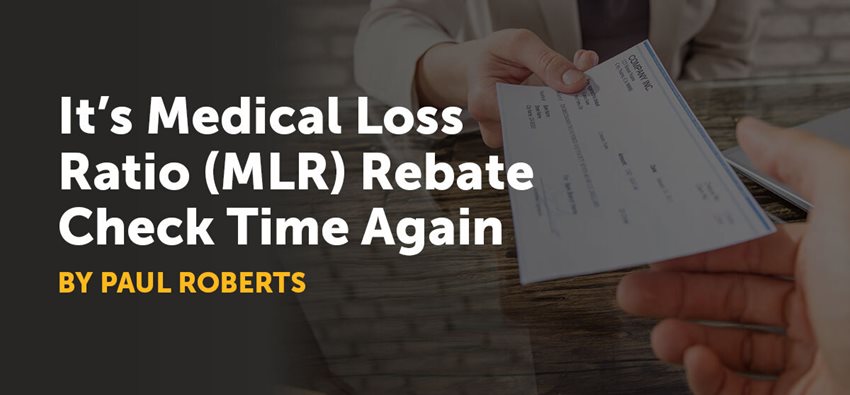Medical Loss Ratio (MLR) Rebates for 2025 – What Employers Need to Know

The Affordable Care Act (ACA) introduced Medical Loss Ratio (MLR) requirements for fully insured medical plans. These rules require insurers to spend a substantial portion of premium dollars on actual health care services and quality improvements. In turn, they limit the dollars that can go toward administrative costs like marketing, salaries, agent commissions, and profits.
The MLR is calculated on a calendar-year basis. This means the MLR for the 2024 calendar year determines whether rebates are required, and if so, they must be distributed to employers by September 30, 2025.
Under the ACA, the MLR standards are:
- Small Group and Individual (IFP) Plans: At least 80% of premium dollars must be spent on health care services and quality improvement.
- Large Group Plans: At least 85% of premium dollars must be spent in these same categories.
These rules apply only to fully insured plans. Employers with self-funded and level-funded plans are not subject to MLR requirements because they pay claims directly.
What Happens When an Employer Receives an MLR Rebate
Employers have 90 days to determine how to handle a rebate. Covered employees are sometimes notified by their carrier when a rebate is coming, which can create a sense of urgency to act.The Department of Labor (DOL) outlines three allowable approaches:
- Reduce future premiums for all employees: Apply the rebate toward everyone’s premium share for the next plan year, regardless of which plan they are on.
- Reduce future premiums only for impacted subscribers: Apply the rebate only to employees (and COBRA participants) who were covered by the plan that generated the rebate.
- Cash refunds: Provide the rebate directly to employees who were covered under the plan that generated it.
Group Health Plan Rebates Are Small at Best – and the Tax Conundrum
More than a decade after the ACA’s major provisions took effect in 2014, most group health plan carriers have become highly skilled at setting rates that meet MLR targets. Strong group market risk pools and refined actuarial practices mean many carriers will not need to issue rebates at all.When rebates are required in the group markets, they are usually modest – often $10 to $30 per employee. Issuing checks for these amounts can create unnecessary administrative work and may also result in taxable income for employees, particularly when a Section 125 Premium Only Plan (POP) is in place.
To minimize the burden, many employers:
- Apply the rebate toward future premium payments.
- Use the funds to enhance benefits rather than issuing checks.
Best Practices for Handling MLR Rebates
No matter which method is chosen, employers should:
- Put the decision in writing.
- Apply it consistently to all similarly situated employees.
- Communicate it clearly to employees.
- Include it in ERISA plan documents.
Carrier-Specific MLR Rebate Information for 2025
We are reaching out to our fully insured carrier partners in California and Nevada to confirm their 2025 rebate status for the 2024 calendar year. This section will be updated as additional carrier responses are received.| Carrier | Will you issue an MLR rebate in 2025? | Timing | Notes / Links |
|---|---|---|---|
| Aetna (CA and NV) | California – No. Nevada – Yes, Large Group, Aetna Health Inc. |
Rebates will be mailed by September 30th. | 2024 MLR Experience Year Rebate Pools |
| Anthem Blue Cross (CA) | No. | N/A. | N/A. |
| CalCPA Health (CA) | No. | N/A. | N/A. |
| Health Net (CA) | No. | N/A. | MLR Results |
| Kaiser Permanente (CA) | No. | N/A. | N/A. |
| MediExcel Health Plan (CA) | No. | N/A. | N/A. |
| Nippon Life Benefits (CA/NV) | Yes. | Rebates will be mailed in September. | Minimum Loss Ratio (MLR) Rebate Process FAQ |
| Seniors Choice | No. | N/A. | N/A. |
| Sharp Health Plan (CA) | No. | N/A. | N/A. |
| SIMNSA (CA) | No. | N/A. | N/A. |
| Sutter Health Plus (CA) | No. | N/A. | N/A. |
| Total Benefit Solutions (CA/NV) | Yes. | Rebates will be mailed by September 30th. | 2024 MLR Experience Year Rebate Pools |
| UnitedHealthcare (CA) | Yes. | Rebates will be given out from September 15 to September 30, 2025. | Mailing for MLR premium rebate checks beginning in September |
Check back for updates. We will post carrier responses here as they come in.
Most Recent Articles
Technology

